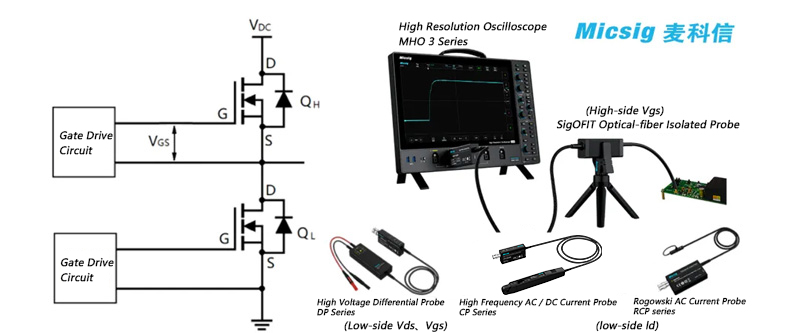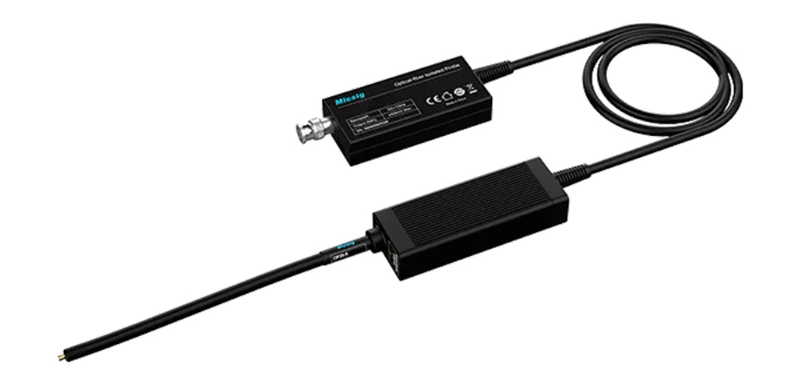Updated:2024-07-11
Wide bandgap (WBG) semiconductor materials such as silicon carbide (SiC) and gallium nitride (GaN) not only excel in high-temperature and high-voltage endurance but also exhibit characteristics like low loss and fast switching frequencies. However, to fully harness the potential of these advanced materials, precise testing and measurement techniques are crucial. In particular, in double-pulse testing, optical isolation probes not only ensure the safety of the testing process but also enhance the accuracy and reliability of the measurements. This article delves into why optical isolation probes are indispensable in double-pulse testing.
What is Double Pulse Testing?
Double-pulse testing (DPT) is an experimental method used to evaluate the switching performance of power electronic devices such as Insulated Gate Bipolar Transistors (IGBTs) or Metal-Oxide-Semiconductor Field-Effect Transistors (MOSFETs). This test involves applying two short-duration voltage pulses to the device, simulating its switching behavior in actual circuits. It is used to measure and analyze the switching characteristics of the device, optimize device drive and application design, and for fault diagnosis and validation of simulation models.
The choice of oscilloscope and probes in DPT
In the example of the half-bridge gate driver circuit for MOSFETs, we need to test the Vds, Id, and Vgs of the lower MOSFET, and also observe the Vgs of the upper MOSFET. The choice of the Micsig MHO high-resolution oscilloscope series, with 500MHz bandwidth, 3GSa/s sampling, ≤1% accuracy, all 4 channels supporting simultaneous observation of both upper and lower MOSFET switches, perfectly meets the testing requirements for DPT (Double-Pulse Testing).

To accurately measure the Id waveform, it's crucial to ensure that the current probe used has sufficient bandwidth. Use Micsig high-frequency AC/DC current probe CP series, which has up to 100MHz bandwidth, accuracy within 1%, resolution down to 1mA, and supports measurements up to 30A. For testing requirements involving larger currents, can use the Rogowski AC probe RCP series
However, many users may have question: "We have the Micsig DP series high-voltage differential probes, which performed well when testing silicon devices, even measuring voltages up to 7000V with a bandwidth of 500MHz. Now, switching to GaN and SiC devices, theoretically, the probes should meet the bandwidth requirements of these devices. They can test the lower MOSFET, but why do we always encounter issues when testing the voltage of the upper MOSFET?".

Switching time of SiC and GaN
By analyzing and comparing the data from the above figure, we found that both SiC and GaN switches have achieved switching speeds in the nanosecond. This significant advantage reduces the energy consumption of switching power supplies, but it also poses a major challenge for testing. In a half-bridge circuit, the Vgs of the high-side MOSFET floats between turning ON and OFF of the Vds voltage, which can change from zero volts to thousands of volts in just a few nanoseconds. The combination of high voltage and high frequency leads to a significant increase in high-order harmonic components. The differential voltage Vgs of our device under test is often only a few tens of volts, and it significantly experiences common-mode interference from the high-order harmonic components of Vds. When measuring, we need to suppress this common-mode interference as much as possible. This requires that the test equipment maintains high common-mode rejection ratio (CMRR) even in the high-frequency range.
Taking the DP series as example, at 100 kHz, the CMRR is >-70 dB; at 20 MHz, CMRR is > -40 dB; and at 120 MHz, CMRR is > -26 dB. For differential probes, this CMRR is already considered excellent among peers. However, it is still far from sufficient to meet our requirement for measuring the gate-source voltage (Vgs) of the high-side MOSFET at high frequencies. We need a device that maintains a very high CMRR even in the high-frequency range.
Comparison of high voltage differential probe and optically isolated probe
Regarding the impact of CMRR on testing, let's make a comparison to see the problems caused by high-voltage differential probes during testing and the comparison of probes with high CMRR.

SiC IGBT DPT test, both optically isolated probe and differential probe connected to the Vge of the upper bridge
Testing method: The device under test is a SiC switch with high and low gates, operating at approximately 500V Vce voltage. Simultaneously use high-voltage differential probe (Micsig DP) and optically isolated probe (Micsig SigOFIT) connected to the high side Vge signal, for double-pulse testing.

SiC IGBT DPT test waveform comparison: SigOFIT probe (Red) and DP probe (White)
The above figure shows the test result. The white signal represents the result from the high-voltage differential probe. It can be observed that during the rising edge of Vge, there is severe oscillation, making it almost impossible to distinguish the original waveform. We previously used a high-voltage differential probe to test the upper gate (Vge) signal of a device with Vce voltage reaching 800V, and the oscillation exceeded the SiC's turn-off voltage, significantly affecting the engineer's assessment.
While the red waveform in the figure was obtained using optically isolated probe, resulting in significantly less signal interference. When tested independently with an optically isolated probe, there is almost no interference. The interference observed here is caused by the high-voltage differential probe affecting the optically isolated probe. In fact, optically isolated probe have lower baseline noise compared to high-voltage differential probe, providing higher accuracy and the ability to measure larger common-mode voltages. How is this achieved?
Advantages of optically isolated probe
Micsig’s exclusive SigOFIT™ technology to select the attenuator suitable for the signal size to be tested before testing, so that the differential mode signal from ±0.01V to ±6250V can be tested at full scale. While adapting to a wide range of tests, it improves the test accuracy (up to 1%), reduces the noise floor, and improves the signal-to-noise ratio.

Key specifications of SigOFIT optical-fibre isolated probe
With a bandwidth of up to 1GHz, the SigOFIT probe noise can be within 0.45mVrms. Even in the 1GHz frequency range, the CMRR remains above 100dB. Therefore, when using an optically isolated probe to measure the high-side Vgs, there is no need to consider the impact of common-mode interference, perfectly resolving the issue of insufficient CMRR in high-voltage differential probes."

Micsig SigOFIT optical-fibre isolated probe
In addition, due to the length of the leads (generally around 20cm), differential probes can act like antennas, picking up external magnetic field interference. Given the extremely fast switching speed of GaN, the magnetic fields it generates can induce oscillations when passing through the input of high-voltage differential probes, sometimes exceeding certain limits and causing instantaneous burnout or explosion of the GaN devices. Optically isolated probes, on the other hand, use MCX or MMCX connections with very short leads, virtually eliminating the antenna effect. Parasitic capacitance is within a few pF, effectively eliminating safety hazards caused by parasitic effects during test.
Conclusions
In summary, the optical isolation probe has actually surpassed the differential probe in all aspects of performance. For users who need to conduct double pulse testing, the Micsig optical isolated probe is the best choice.
Misconception of Signal Frequency in Bridge Circuits of Power Devices: Difference Between Switching Frequency and Signal Frequency
2024.07.12
Performance and Appearance Upgrade | Micsig High Frequency AC/DC Current Probe CP Series Fully Upgraded, Lower Noise, More Exquisite Appearance
2024.06.18

